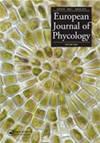Rare earth elements in brown algae of the genus Cystoseira (Phaeophyceae) (Black Sea)
IF 1.7
4区 生物学
Q2 MARINE & FRESHWATER BIOLOGY
引用次数: 2
Abstract
Abstract Rare earth metals are widely used in various technologies, and their environmental impact needs to be assessed. Brown algae are recognized bioindicators of xenobiotic pollution in coastal marine areas, so we studied the rare earth element contents in short-lived branchlets of the two most abundant species of Cystoseira (C. barbata and C. crinita) on Black Sea coasts. The abundance of rare earth elements including scandium (Sc), yttrium (Y), lanthanum (La) and 14 lanthanides in the algae, seawater and sediments were determined using inductively coupled plasma mass spectrometry. The average contents of the prevalent elements in the algae decreased in the following order: Sc ≥ La > Europium (Eu) > Y > Neodymium (Nd) > Cerium (Ce). The factors affecting rare earth element content were age > locality > species of the alga. Most of the rare earth metals reached their maximum levels in branchlets > 5 month old, presumably associated with biosorption processes, whereas others (Eu, Terbium (Tb), Lutetium (Lu)) were most concentrated in 2–5 month old branchlets. In contrast to existing reports on the possible use of brown seaweeds for monitoring rare earth elements in coastal waters, the suitability of Cystoseira spp. branchlets, which have a 7 month life cycle, for short-term rare earth contamination monitoring was not confirmed in this study. Highlights Cystoseira spp. branchlets accumulate many rare earth elements with age. The dominant elements in Cystoseira spp. are Sc ≥ La> Eu > Y > Nd > Ce. The most significant factors affecting rare earth element content are age > locality > species.黑海褐藻(褐藻科)中的稀土元素
稀土金属广泛应用于各种技术中,其环境影响需要进行评估。褐藻是沿海海域公认的外源污染的生物指标,因此我们研究了黑海沿岸最丰富的两种囊藻(C. barbata和C. crinita)短寿命小枝中的稀土元素含量。采用电感耦合等离子体质谱法测定了藻类、海水和沉积物中钪(Sc)、钇(Y)、镧(La)和14种镧系元素的丰度。藻类中主要元素的平均含量依次为:Sc≥La > Europium (Eu) > Y >钕(Nd) >铈(Ce)。影响稀土元素含量的因素有年龄、地点、藻类种类等。大多数稀土金属在5 ~ 5月龄的小枝中含量最高,可能与生物吸附过程有关,而其他稀土金属(Eu、Terbium (Tb)、Lutetium (Lu))在2 ~ 5月龄的小枝中含量最高。与已有的褐藻可能用于监测沿海水域稀土元素的报道不同,本研究未证实生命周期为7个月的Cystoseira spp.小枝是否适合用于短期稀土污染监测。随着年龄的增长,Cystoseira sp .的小枝会积累大量的稀土元素。Cystoseira的优势元素为Sc≥La b> Eu b> Y b> Nd b> Ce。影响稀土元素含量最显著的因素是年龄>、地点>、种类>。
本文章由计算机程序翻译,如有差异,请以英文原文为准。
求助全文
约1分钟内获得全文
求助全文
来源期刊

European Journal of Phycology
生物-海洋与淡水生物学
CiteScore
4.80
自引率
4.20%
发文量
37
审稿时长
>12 weeks
期刊介绍:
The European Journal of Phycology is an important focus for the activities of algal researchers all over the world. The Editors-in-Chief are assisted by an international team of Associate Editors who are experts in the following fields: macroalgal ecology, microalgal ecology, physiology and biochemistry, cell biology, molecular biology, macroalgal and microalgal systematics, applied phycology and biotechnology. The European Journal of Phycology publishes papers on all aspects of algae, including cyanobacteria. Articles may be in the form of primary research papers and reviews of topical subjects.
The journal publishes high quality research and is well cited, with a consistently good Impact Factor.
 求助内容:
求助内容: 应助结果提醒方式:
应助结果提醒方式:


